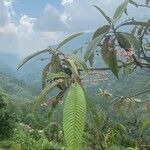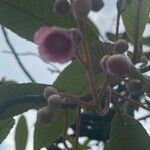Trees 4-20 m tall. Branchlets brown pubescent to glabrescent, with setose hairs intermixed with subulate scales. Petiole 2.5-5 cm, pubescent to glabrescent, with minute hairs intermixed with subulate and unguiculate scales; leaf blade narrowly elliptic to oblong-obovate, 13-36 × 7-15 cm, thinly leathery, abaxially sparsely ferruginous tomentose, indumentum caducous or not, sparsely scaly on midvein and lateral veins, adaxially glabrescent, sometimes with scales at base of midvein, lateral veins 28-40(-46) pairs, base obtuse to subrounded to cuneate, margin finely serrate, apex acuminate to acute. Inflorescences 12-33 cm, axillary, sparsely scaly and puberulent; peduncle ca. 1/2 as long as inflorescence, with 1 or 2 bracts at base of each branch; pedicels 1.7-2.5 cm, with 2 nearly opposite bracteoles below middle; bracteoles caducous, lanceolate, 2-4 mm. Flowers pink to purplish, 0.8-1.5 cm in diam. Sepals unequal, outer 3 smaller, elliptic to broadly elliptic; inner 2 larger, broadly elliptic to orbicular, 5-7 mm. Petals oblong, ca. 8 mm, connate at base, recurved at apex. Stamens 50-90. Ovary globose to depressed-globose; styles 4 or 5, connate below middle. Fruit green to yellowish, globose to depressed-globose, ribbed or slightly ribbed. Fl. Jun-Dec, fr. Jun-Dec.
More
A large deciduous shrub or small tree. The bark is reddish and the wood soft and spongy. The leaves are large and narrowly oval and have rusty hairs underneath. The leaves are 18-36 cm long. There are prominent side veins and teeth along the edge. The young leaves are very rusty coloured and hairy. The flowers are pink and in clusters in the axils of the leaves. There are many flowers and they are about 1.3 cm across. They have 5 petals that have fringes at the edges. The fruit are green and have 4-5 lobes. They are fleshy with a sweet pulp and are edible.



